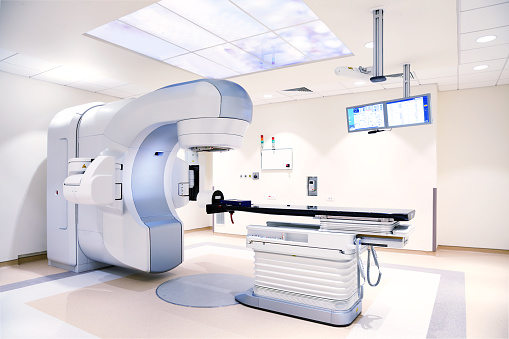External beam radiation therapy is radiation treatment that comes from outside of your body.
A machine called a linear accelerator delivers the radiation treatments. This machine uses electricity to make the radiation beams.

You cannot feel the radiation beams. Radiation treatment does not hurt.
For all types of external radiation treatments, you will need a planning CT scan. This can happens before your treatment. It helps your health care team plan your treatment. For more information, click on "Your Treatment Pathway" on the Having RT tab. You may also need other types of scans such as MRI or PET.
On your radiation treatment days, your radiation therapists may also take other images. This helps them make sure you are in the right position for your treatment. This is called image-guided radiation therapy or IGRT.
You will need to lie very still during your radiation treatments.
Intensity modulated radiation therapy, or IMRT, is radiation therapy where the shape of the radiation field changes during treatment. The radiation field is the area on the body that gets radiation. We shape the radiation field so that the tumour, or where the tumour was, gets a high dose. The normal tissue around the tumours gets a lower dose or no radiation.
Volumetric Modulated Arc Therapy, or VMAT, is a type of intensity modulated radiation therapy (IMRT). The big difference with VMAT is the treatment machine moves around you in a circle during treatment. This motion allows us to change the radiation field even more.
3D conformal radiation therapy, or 3DCRT, gives radiation closely fitted to the treatment area. First, the radiation oncologist decides what area needs to be treated. We then shape the radiation beams match this area. We also angle the radiation beams from the treatment machine to target the treatment area and avoid healthy tissue.
Stereotactic radiation therapy uses special equipment to position the patient. There are two types of special equipment: masks and body moulds (a hard cushion fitted to your body). This equipment allows us to give radiation in a more precise way. When we use this equipment, we can give higher doses of radiation with each treatment.
Stereotactic radiation therapy does not work for all types of cancers or tumours.
When we give stereotactic radiation is to the body (such as the lungs, liver, or bones), we call it stereotactic body radiation therapy (SBRT) or stereotactic ablative radiation therapy (SABR). We give this radiation in 3 to 8 treatments. The treatments might not be every day. We may space them out with a day in between treatments.
If you need a body mould, we will create it during your radiation planning. You may also need a mask, or shell, around your head and shoulders.
There are two ways to give stereotactic radiation to the brain:
- A single treatment called stereotactic radiosurgery (SRS)
- Multiple treatments, called stereotactic treatment (SRT).
For stereotactic treatments to the brain, you need a mask to keep your head very still. This mask will be tight but should not be uncomfortable.
